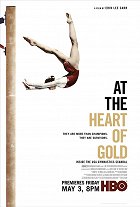Juonikuvaukset(1)
Erin Lee Carr’s At the Heart of Gold outlines the modern USA Gymnastics apparatus, from Svengalian husband-and-wife coaching team Bela and Martha Karolyi as rulers of a severe training camp to the countless officials, like those at Michigan State University, who enabled and covered up the sexual abuse of hundreds of young women by USA Gymnastics national team doctor Larry Nassar. Through detailed archival footage, revealing first-person interviews with key players, and excerpts of the heartbreaking victim impact statements delivered by 150 women in Michigan state Judge Rosemarie Aquilina’s court during Nassar’s trial, the film serves as an indictment of the systematic consumption of the labor of young women for the benefit of powerful adults and a corrupt institution. The narrative centers around current and former gymnasts who trained, competed, and won titles and medals, and bolstered the coffers of USA Gymnastics. At the Heart of Gold follows the money and it leads to the abuse of the bodies of young girls deemed disposable. But the films also highlights their efforts to fight back and earn the most important title of their lives: survivor. (Tribeca Film Festival)
(lisää)Arvostelut (1)
Not long after Leaving Neverland, HBO aired another outstanding documentary, this time examining a case of sexual abuse of children and adolescents perpetrated over the course of many years. Larry Nassar exploited his position as a doctor for the United States national gymnastics team for more than twenty years. He “treated” back pain and other problems by, among other things, inserting his fingers into the vaginas of young gymnasts. Often in the presence of their parents, which reinforced in the girls the belief that, as a doctor, he knew what he was doing and was helping them to continue to perform at the highest possible level and to earn money from sponsors (“He was a doctor. He must have had a reason for doing that.”). ___ The aggressiveness of his "vaginal treatment" increased with the age of the athletes, who believed that he wanted to help them, because, unlike their despotic coaches, they found psychological support and understanding in him (with regard to this topic, I also recommend the Polish documentary Over the Limit). The cooperation of Nassar’s colleagues from the ranks of coaches and experts at the university where he worked contributed to the fact that his behaviour was long concealed and downplayed and, before he was sentenced to 175 years behind bars, that more than 300 women became his victims. ___ His friends and members of the local community did not want to damage his reputation, or rather did not believe that he would be capable of doing such a thing, as it did not correspond to his image as a nice person and respected medical authority. Rather, doubts were raised about the testimonies of the girls, who in the end felt guilty for telling someone about the harassment and thus imperilling Nassar’s reputation. Through the open testimonies of individual gymnasts and their parents, as well as of experts, the documentary describes not only the tactics used by the sexual predator and the psychological trauma of the victims (which in some cases is exacerbated by disruption of family relationships because the parents did not believe their daughters), but also the culture of sexual harassment fostered in part by numerous institutions (including the US Olympic Committee). On the one hand, there is the fear that accompanies the idea of speaking out against an influential person, while on the other hand, there is strong mistrust. In such an atmosphere and under those conditions, it is not enough to merely talk about it, which is painful in and of itself. 80%
()

